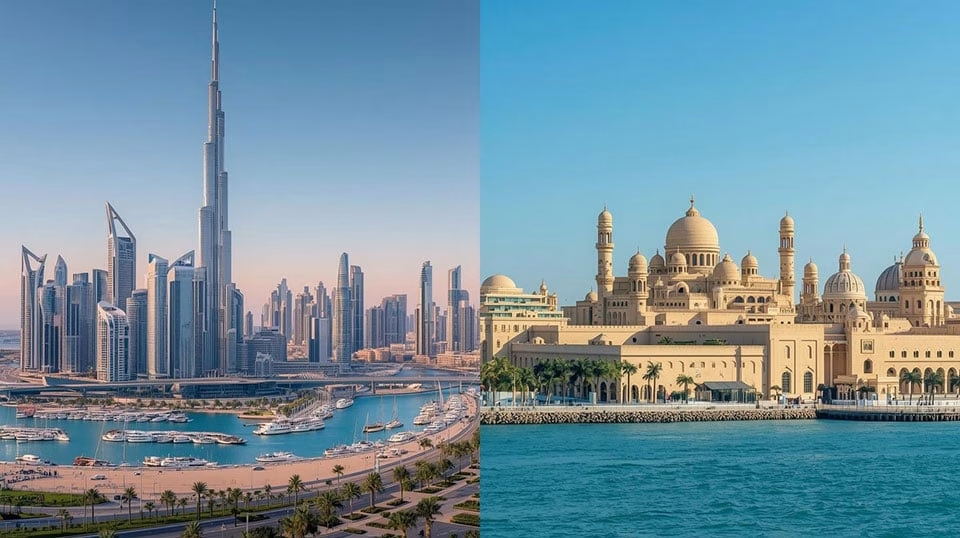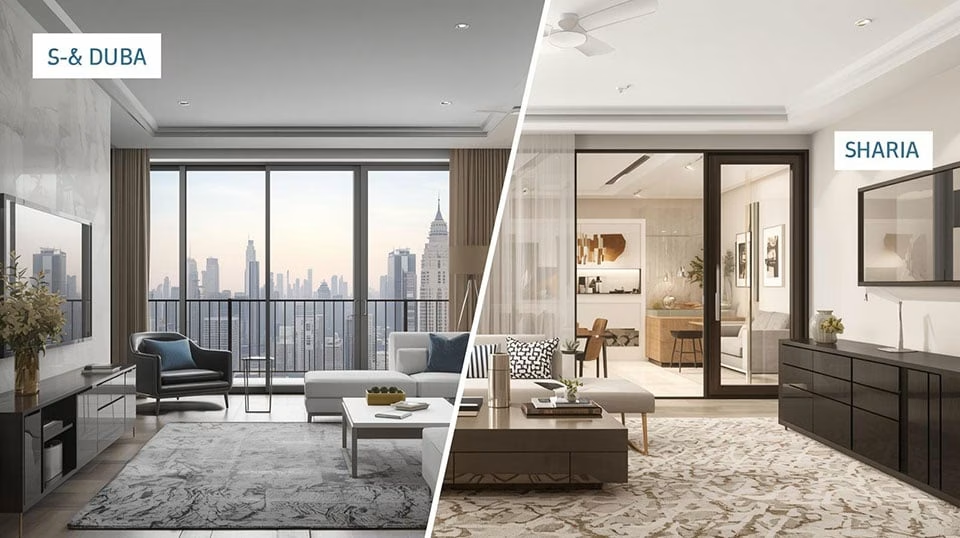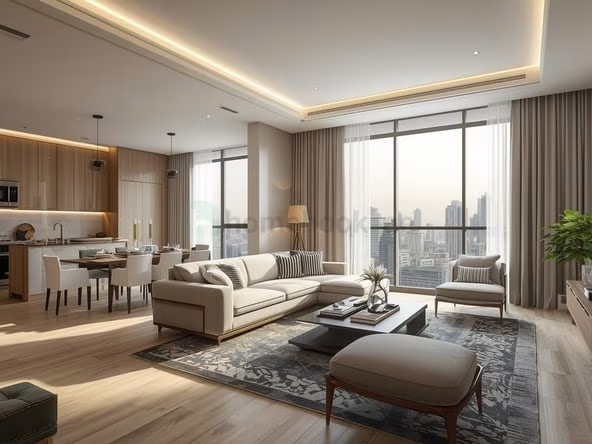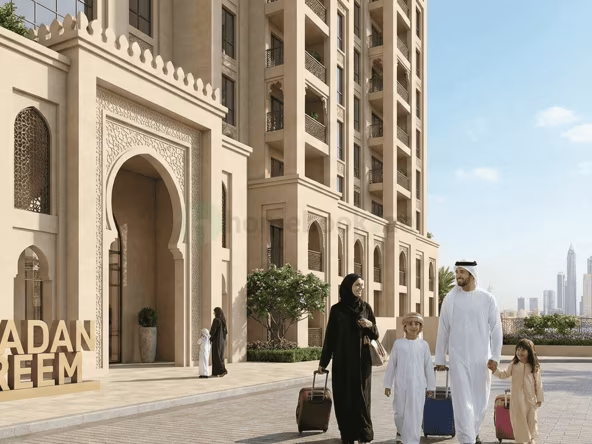Rents in Dubai and Sharjah don’t look alike, even though the two emirates are only a short drive apart. In Dubai, room prices rise quickly thanks to constant demand, new projects, and its reputation as a global city.
Sharjah offers a different picture — quieter neighborhoods, family settings, and rooms that usually cost far less. This price gap makes people stop and compare. Should someone pay extra to stay in Dubai and cut down on travel, or keep costs low by renting in Sharjah and commuting each day? That’s the real choice many face.
Homebook helps clear things up by comparing room rent Dubai vs Sharjah, showing average room rental prices Dubai, and pointing out areas in Sharjah where it’s still possible to find affordable rooms without much hassle.
Why Rental Costs Differ Between Dubai & Sharjah
Ask anyone who’s been house-hunting in the UAE and you’ll hear the same thing: room rent Dubai vs Sharjah is a completely different ball game. You can cross the border in under half an hour, but the price tag on a room changes fast.
Dubai is where the money flows. It’s the city of shiny towers, endless new projects, and a constant stream of expats looking to be right in the middle of it all. That demand alone keeps room rental prices Dubai on the higher side, and landlords know they can charge more because people are willing to pay for location and lifestyle.
Sharjah, meanwhile, feels calmer and more traditional. Families, students, and commuters find that the balance works better here because rents are much lower. You’ll see plenty of listings for affordable rooms Sharjah, and while you may have to deal with a longer commute into Dubai, the savings each month can be huge.
The gap really comes down to four things: the local economy, the number of expats competing for space, the lifestyle each emirate offers, and where the property actually sits on the map.
Average Room Rental Rates in Key Areas of Dubai
Room rental prices Dubai vary a lot depending on where the search begins. Some parts of Dubai are built for luxury living, while others are better suited to workers, families, or students trying to save money.
Downtown Dubai and Business Bay
Right in the center of the city, these areas offer quick access to offices, shopping malls, and nightlife. The downside is the price. Private rooms often fall between AED 4,000 and 6,000 a month, and even shared rooms rarely go below AED 2,500.
Bur Dubai, Deira, and Karama
These older districts are always full of life. They attract long-term residents who want something more affordable but still close to the metro and markets. A private room here usually costs AED 2,500–3,500, while shared spaces range from AED 1,500–2,000.
International City and Al Nahda, Dubai
These neighborhoods are known for lower rents and a more budget-friendly setup. Many expats choose them to keep living costs down without moving out of Dubai completely. Many expats choose them to cut costs without leaving Dubai. Shared rooms often range from AED 900–1,400, while private ones average AED 1,800–2,500.
Dubai’s prices are clearly higher than the cost of renting room Sharjah, where many tenants find affordable rooms Sharjah for much less. That’s why so many residents weigh the trade-off between comfort, convenience, and price before signing a lease.

Typical Room Rental Prices in Sharjah Neighborhoods
Different parts of Sharjah cost very different amounts. Trying to get a feel for the cost of renting room Sharjah? These numbers help see what’s normal in each place.
Al Majaz, Al Nahda, Al Qasimia (Expat-heavy, mid-range)
These areas are popular with people who want good amenities but don’t want the super high end. In Al Nahda, rooms with bills included show up for about AED 1,800–2,300/month.
In Al Qasimia, there are furnished or partly furnished rooms around AED 1,700/month.
Al Majaz also has partitions or shared spaces (e.g. bed-space style) for AED 500–600/month — basic, but very inexpensive.
Industrial Area & Outskirts (Most of the affordable rooms Sharjah)
For cheaper options, the Industrial Area and edges of Sharjah offer lower prices. There are listings for furnished rooms in Industrial Area 1 around AED 1,200/month.
More comfortable rooms or master bedrooms here might go for AED 1,700–1,800/month, depending on size and condition.
Practical Tips
Check the bills. Some rents include utilities; others don’t. Paying extra for electricity or water can change your cost a lot.
Shared vs private. Shared rooms (more than one person) tend to be much cheaper. If okay with sharing, big savings are possible.
Condition matters. A nicer finish or more furniture means more rent, even in the same area.
Distance adds up. Outskirts can be affordable, but transportation costs (bus, taxi, fuel) reduce those savings.
Use Homebook to monitor current listings. Things shift fast; what’s affordable now may change next month.
What’s Included: Comparing Utilities, Amenities & Hidden Costs
In most shared or private rooms, utilities are typically included in the contract. Some landlords also add internet, but it’s not guaranteed, so it’s important to double-check the details on Homebook before signing.
Furniture makes a big difference, too. A furnished room may already have the basics — a bed, a wardrobe, an air conditioner, and sometimes kitchen items. An unfurnished one means buying those things yourself, which can quickly raise costs.
Parking and upkeep can add to the rent. In Sharjah, the extra charges are usually small. In Dubai, it’s a different story. Big towers with gyms, pools, or security often come with service fees, and those can push the total price up.
Hidden costs to check: agency fees (if using a broker), security or deposit charges, utility connection fees. These can raise the up-front cost a lot.

Sharp Differences: Dubai vs Sharjah
In Sharjah, hidden costs tend to be lower. Buildings are often older, with fewer luxury amenities, less complex management charges. So the cost of renting room Sharjah usually stays closer to what you see in the ad. Finding truly affordable rooms Sharjah is more realistic there.
In Dubai, rents more often include fancy extras — pools, gyms, modern lobby, maybe 24-hour security. But those extras often come with extra fees. Also, more listings state “bills included,” but not always all bills — sometimes internet or district cooling are extra. That affects room rental prices Dubai more.
How Location Impacts Price: Transport & Proximity to City Centers
Being close to a metro station or major bus hub in Dubai usually pushes rent up. It saves time getting to work, malls, or lunch spots. Areas like Dubai Marina, Downtown, or close to new metro lines cost more because people want that ease.
In contrast, Sharjah has fewer metro lines (soon there might be more), so many people rely on buses, car-carpools, or pick-ups. That means living a little farther can save rent, but adds daily transport costs.
When rents are cheaper in Sharjah, transport expenses (bus fares, taxi or shared ride, fuel) can add up. For example, a bus from Sharjah to Dubai might cost ~ AED 12-17, depending on the route. If commuting daily, that adds money, time, and stress.
In Dubai, being near the metro makes it possible to avoid traffic delays and reduce the cost of driving or parking. That convenience is part of what makes room rental prices Dubai higher in certain districts.
For many renters, balancing cheaper rent with travel time & cost is key. Sometimes paying a bit more for a place closer to transport can save overall money (and mood) every day.
Shared Rooms vs Private Rooms: Price Differences in Both Emirates
| Type of Room | What It Means | Typical Price in Dubai | Typical Price in Sharjah |
| Shared Room Bed-space Partition | A bedroom or partition shared with others, communal living areas (kitchen, bathroom). | From ~ AED 1,000-1,500/month in cheaper areas.
Some shared rooms go up when amenities or location improve. |
Affordable rooms Sharjah are often in shared or partitioned spaces, around AED 900-1,500/month, depending on area and whether furnished. |
| Private Room (in shared flat or villa) | Own bedroom; shared common spaces; more privacy; fewer people in your room. | Private rooms typically range from AED 2,000-3,500/month or more in mid / better locations. | Private rooms in mid-Sharjah areas cost ~ AED 1,600-1,900/month, sometimes a bit more if furnished or with extras. |
Prices depend heavily on area (how close to metro/train, malls, etc.), condition of the room, furnishings, and amenities.
Tips & Observations
Shared rooms are clearly cheaper. Sharing a room is usually the cheapest choice, which is why many workers and students go for it.
Having a private room costs more, but it gives privacy and quiet — no need to deal with several people in the same space.
In Dubai, the price jump from shared to private is large. The city’s high demand and newer buildings make private rooms much more expensive.
In Sharjah, the difference isn’t as sharp. Moving from shared to private still adds to the rent, but not as heavily as in Dubai. You still pay extra for private, but the jump isn’t as big, especially in areas like Al Nahda or Qasimia.
Always check what’s included in the price: utilities, internet, AC, and furnishings. Sometimes the “private room” cost looks high, but it includes a lot. Other times, “shared room” looks cheap, but utilities or extras are missing.
Best Value Neighborhoods in Dubai & Sharjah for Room Rentals
Dubai – International City, Discovery Gardens, Al Nahda
These areas are known for lower rents compared to central districts. Rooms here give more space for less money.
The trade-off is a longer commute and fewer luxury extras, but everyday needs are still within reach. Listings on Homebook often show shared rooms starting from budget rates and private rooms at mid-range prices.
Sharjah – Al Majaz, Al Qasimia, Muwaileh
These neighborhoods strike a balance between comfort and cost. They have supermarkets, schools, and easy access to Dubai by bus or car. Renters looking for affordable rooms Sharjah will often find good value here.
Homebook highlights these areas as some of the most popular choices for students and families wanting lower costs without giving up too much convenience.

Timing Your Rental Search: When Prices Are Lower
In Dubai, rents tend to drop between April and September. Fewer people move then because of the hot weather. Landlords often offer discounts.
Major events like Expo raise demand. Before or during big events, prices go up. After the events, there might be more supply and a chance for better deals.
Best months to negotiate? Try the hotter ones — June, July, August. Also, just after the big event season, when many leases renew. Less demand → more flexibility.
Tips to Save Money When Renting in Either Emirate
- Ask the landlord if rent is negotiable. Many allow a discount if the place has been empty for a while.
- Sign a yearly lease instead of shorter terms. Longer contracts often come with better rates.
- Share the flat or villa with roommates. Splitting rent and bills eases the cost burden.
- Try to avoid using brokers if possible. Going directly via platforms like Homebook can cut out extra commission fees and get you savings.
Conclusion
Dubai and Sharjah sit close, but their rents tell two different stories. Dubai is about comfort, quick access to offices, and plenty of modern extras — but you pay for it. Sharjah is lighter on the budget, and it’s not hard to find affordable rooms across the city.
The catch with Sharjah is the daily trip into Dubai. It takes time, and it can be tiring. What matters most is different for everyone. Some people prefer to save as much as possible. Others pay extra just to live closer to work and the city’s busy life.
In the end, each renter has to weigh the rent, the lifestyle, and the commute before choosing.
Frequently Asked Questions
Sharjah is usually cheaper than Dubai.
Yearly contracts are cheaper than short stays.
Yes. Utilities and cooling cost more in Dubai.
Rent is lower, but travel time and fares can add up.
Deposits, agency fees, and maintenance charges.



